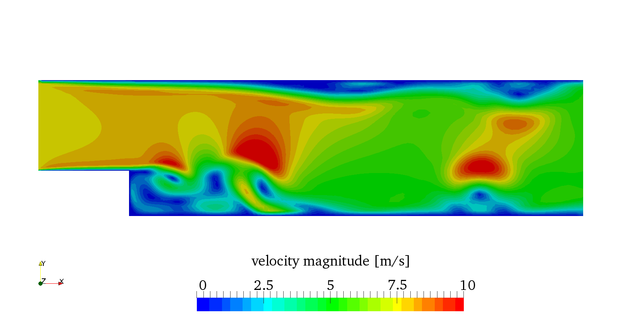Difference between revisions of "Transient turbulence modeling by Jozsef Nagy"
Jump to navigation
Jump to search
Jozsef Nagy (talk | contribs) (Created page with "* '''author''': Jozsef Nagy * '''affiliation''': Institute of Polymer Injection Molding and Process Automation, Johannes Kepler University Linz, Austria * '''contact''': jozse...") |
Jozsef Nagy (talk | contribs) |
||
| (22 intermediate revisions by 2 users not shown) | |||
| Line 1: | Line 1: | ||
| − | * ''' | + | [[category:turbulence]] |
| − | * '''affiliation''': | + | [[category:RAS]] |
| − | * '''contact''': | + | [[category:LES]] |
| − | * '''OpenFOAM version''': | + | * '''contributor''': Jozsef Nagy |
| − | * '''Published under''': CC BY-NC-SA license ([https:// creativecommons.org/licenses creative commons licenses]) | + | * '''affiliation''': eulerian-solutions e.U., Linz, Austria |
| + | * '''contact''': <mail address='jnmlujnmlu@gmail.com' description='author'>click here for email address</mail> | ||
| + | * '''OpenFOAM version''': v2006 | ||
| + | * '''Published under''': CC BY-NC-SA license ([https://creativecommons.org/licenses creative commons licenses]) | ||
Go back to [https://wiki.openfoam.com/index.php?title=Day_7 Day 7]. | Go back to [https://wiki.openfoam.com/index.php?title=Day_7 Day 7]. | ||
| − | =[https:// www.youtube.com/watch?v=l8jDBPN4rXo Transient turbulence modeling (RAS,LES)]= | + | =[https://www.youtube.com/watch?v=l8jDBPN4rXo Transient turbulence modeling (RAS,LES)]= |
| − | + | [[File:vel_jnagy2.png|625px|right|transient velocity distribution]] | |
| − | + | Most of the real life problems you would like to tackle include some sort of turbulence. These [https://www.youtube.com/watch?v=l8jDBPN4rXo videos] | |
| − | |||
| − | + | * [https://www.youtube.com/watch?v=l8jDBPN4rXo part 1] | |
| + | * [https://www.youtube.com/watch?v=DTpkJK9fSLI part 2] | ||
| − | * transient turbulence | + | will give you a detailed explanation on transient turbulence modelling in OpenFOAM. Often you cannot avoid to explicitly depict the transient phenomena in a turbulent flow. For that you have to be able to choose the correct model. Additionally you have to understand the difference between RAS and LES models. In this tutorial you will learn about |
| + | |||
| + | * transient turbulence modelling | ||
* URANS models | * URANS models | ||
* Large Eddy Simulations | * Large Eddy Simulations | ||
* case setup | * case setup | ||
* boundary and initial conditions | * boundary and initial conditions | ||
| − | * | + | * post processing |
| + | |||
| + | You can download the blockMeshDict [https://github.com/jnmlujnmlu/OpenFOAMTeaching/tree/master/JozsefNagy here]. | ||
| + | |||
| + | For older versions of OpenFOAM the blockMeshDict file is located in constant/polyMesh, for newer versions the file is located in system. | ||
| + | |||
| + | In newer versions of OpenFOAM the RASProperties dictionary is replaced by turbulenceProperties, however the important entries remain the same. | ||
| + | |||
| + | In newer versions of OpenFOAM the commands ''yPlus'', ''yPlusLES'' and/or ''yPlusRAS'' are not used. Instead AFTER your simulation run the command ''pisoFoam -postProcess -func yPlus'' | ||
| + | |||
| + | In newer versions of OpenFOAM nuSgs was replaced by nut in order to have a consistent syntax. Just rename nuSgs into nut. | ||
| + | |||
| + | In newer versions of OpenFOAM the LES ''oneEqEddy'' model was renamed, try ''kEqn'' instead. | ||
Revision as of 04:56, 28 July 2020
- contributor: Jozsef Nagy
- affiliation: eulerian-solutions e.U., Linz, Austria
- contact: click here for email address
- OpenFOAM version: v2006
- Published under: CC BY-NC-SA license (creative commons licenses)
Go back to Day 7.
Transient turbulence modeling (RAS,LES)
Most of the real life problems you would like to tackle include some sort of turbulence. These videos
will give you a detailed explanation on transient turbulence modelling in OpenFOAM. Often you cannot avoid to explicitly depict the transient phenomena in a turbulent flow. For that you have to be able to choose the correct model. Additionally you have to understand the difference between RAS and LES models. In this tutorial you will learn about
- transient turbulence modelling
- URANS models
- Large Eddy Simulations
- case setup
- boundary and initial conditions
- post processing
You can download the blockMeshDict here.
For older versions of OpenFOAM the blockMeshDict file is located in constant/polyMesh, for newer versions the file is located in system.
In newer versions of OpenFOAM the RASProperties dictionary is replaced by turbulenceProperties, however the important entries remain the same.
In newer versions of OpenFOAM the commands yPlus, yPlusLES and/or yPlusRAS are not used. Instead AFTER your simulation run the command pisoFoam -postProcess -func yPlus
In newer versions of OpenFOAM nuSgs was replaced by nut in order to have a consistent syntax. Just rename nuSgs into nut.
In newer versions of OpenFOAM the LES oneEqEddy model was renamed, try kEqn instead.
